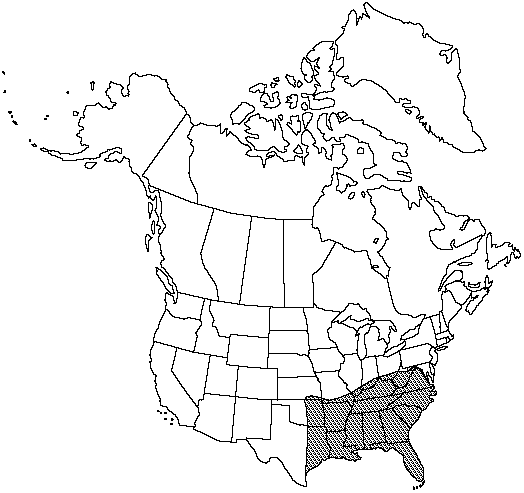Difference between revisions of "Pleopeltis polypodioides var. michauxiana"
in Windham,Contr. Univ. Michigan Herb. 19: 46. 1993.
FNA>Volume Importer |
FNA>Volume Importer |
||
| Line 20: | Line 20: | ||
}}<!-- | }}<!-- | ||
| − | --><span class="statement" id="st- | + | --><span class="statement" id="st-undefined" data-properties=""><b>Stems </b>long-creeping, much branched, 1–2 mm diam.; scales linear to subulate, centrally clathrate with cell luminae occluded, surfaces glabrous, margins denticulate to fringed-ciliate. <b>Leaves</b> to 25 cm, strongly hygroscopic. <b>Petiole</b> grooved, otherwise round in cross section, densely scaly when young; scales often overlapping, margins mostly entire. <b>Blade</b> narrowly triangular to elliptic, deeply pinnatifid, to 5 cm wide, densely scaly abaxially, glabrous adaxially except for a few lanceolate scales along rachis; scales distinctly bicolored, spheric to deltate-ovate, usually less than 0.5 mm wide, centers dark brown, obscurely clathrate, margins broad, transparent, entire to erose. <b>Venation</b> mostly free with occasional areoles, never more than 1 included veinlet in fertile areoles. <b>Sori</b> round, discrete, deeply embossed, forming conspicuous bumps on adaxial surface, soral scales attached at periphery of receptacle. <b>Spores</b> smooth with scattered spheric deposits on surface, 45–52 µm. <b>2n</b> = 74.</span><!-- |
-->{{Treatment/Body | -->{{Treatment/Body | ||
| + | |phenology=Sporulating summer–fall. | ||
|habitat=Epiphytic on various species of trees, especially oaks, magnolias, and elms, or on rocks (usually limestone or sandstone), fence posts, buildings, or mossy banks, usually in moist, shady areas | |habitat=Epiphytic on various species of trees, especially oaks, magnolias, and elms, or on rocks (usually limestone or sandstone), fence posts, buildings, or mossy banks, usually in moist, shady areas | ||
|elevation=0–700 m | |elevation=0–700 m | ||
| Line 42: | Line 43: | ||
|basionyms=Polypodium polypodioides var. michauxianum | |basionyms=Polypodium polypodioides var. michauxianum | ||
|family=Polypodiaceae | |family=Polypodiaceae | ||
| + | |phenology=Sporulating summer–fall. | ||
|habitat=Epiphytic on various species of trees, especially oaks, magnolias, and elms, or on rocks (usually limestone or sandstone), fence posts, buildings, or mossy banks, usually in moist, shady areas | |habitat=Epiphytic on various species of trees, especially oaks, magnolias, and elms, or on rocks (usually limestone or sandstone), fence posts, buildings, or mossy banks, usually in moist, shady areas | ||
|elevation=0–700 m | |elevation=0–700 m | ||
| Line 49: | Line 51: | ||
|publication year=1993 | |publication year=1993 | ||
|special status= | |special status= | ||
| − | |source xml=https://jpend@bitbucket.org/aafc-mbb/fna- | + | |source xml=https://jpend@bitbucket.org/aafc-mbb/fna-data-curation.git/src/9216fc802291cd3df363fd52122300479582ede7/coarse_grained_fna_xml/V2/V2_690.xml |
|genus=Pleopeltis | |genus=Pleopeltis | ||
|species=Pleopeltis polypodioides | |species=Pleopeltis polypodioides | ||
|variety=Pleopeltis polypodioides var. michauxiana | |variety=Pleopeltis polypodioides var. michauxiana | ||
| − | |||
| − | |||
| − | |||
| − | |||
| − | |||
| − | |||
| − | |||
| − | |||
| − | |||
| − | |||
| − | |||
| − | |||
| − | |||
| − | |||
| − | |||
| − | |||
| − | |||
| − | |||
| − | |||
| − | |||
| − | |||
| − | |||
| − | |||
| − | |||
| − | |||
| − | |||
| − | |||
| − | |||
| − | |||
| − | |||
| − | |||
| − | |||
| − | |||
| − | |||
| − | |||
| − | |||
| − | |||
| − | |||
| − | |||
}}<!-- | }}<!-- | ||
-->[[Category:Treatment]][[Category:Pleopeltis polypodioides]] | -->[[Category:Treatment]][[Category:Pleopeltis polypodioides]] | ||
Revision as of 13:26, 27 July 2019
Stems long-creeping, much branched, 1–2 mm diam.; scales linear to subulate, centrally clathrate with cell luminae occluded, surfaces glabrous, margins denticulate to fringed-ciliate. Leaves to 25 cm, strongly hygroscopic. Petiole grooved, otherwise round in cross section, densely scaly when young; scales often overlapping, margins mostly entire. Blade narrowly triangular to elliptic, deeply pinnatifid, to 5 cm wide, densely scaly abaxially, glabrous adaxially except for a few lanceolate scales along rachis; scales distinctly bicolored, spheric to deltate-ovate, usually less than 0.5 mm wide, centers dark brown, obscurely clathrate, margins broad, transparent, entire to erose. Venation mostly free with occasional areoles, never more than 1 included veinlet in fertile areoles. Sori round, discrete, deeply embossed, forming conspicuous bumps on adaxial surface, soral scales attached at periphery of receptacle. Spores smooth with scattered spheric deposits on surface, 45–52 µm. 2n = 74.
Phenology: Sporulating summer–fall.
Habitat: Epiphytic on various species of trees, especially oaks, magnolias, and elms, or on rocks (usually limestone or sandstone), fence posts, buildings, or mossy banks, usually in moist, shady areas
Elevation: 0–700 m
Distribution

Ala., Ark., Fla., Ga., Ill., Ind., Kans., Ky., La., Md., Miss., Mo., N.C., Ohio, Okla., S.C., Tenn., Tex., Va., W.Va., Mexico, Central America in Guatemala.
Discussion
This species is the most widespread epiphytic fern in the flora, although in some parts of its range (e.g., the north) it often occurs on rock. Pleopeltis polypodioides is a common neotropical species, and the North American variety is just one of six that have been recognized. Pleopeltis polypodioides var. michauxiana differs from the other varieties in having more or less entire blade scales and a glabrous adaxial leaf surface. In the southeastern United States (particularly Florida), some plants grade slightly into var. polypodioides, which is common in the West Indies. The latter variety has fringed to denticulate blade scales and scattered scales on the adaxial blade surface. Within its range, Pleopeltis polypodioides var. michauxiana could only be mistaken for Polypodium virginianum Linnaeus, which has similar leaf morphology but lacks scales on the abaxial blade surface.
Selected References
None.